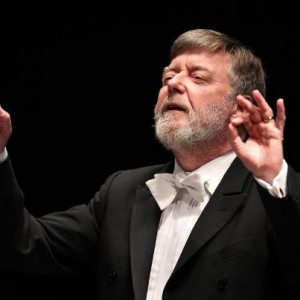
Wednesday’s early Afterworks concert of Richard Strauss’ Don Quixote and Felix Mendelssohn’s Overture to A Midsummer Night’s Dream presented by the Toronto Symphony Orchestra under the direction of Sir Andrew Davis featured introductions by Tom Allen and solo performances by principal viola Teng Li and principal cello Joseph Johnson.
- PREVIEW | Soundstreams Celebrates Mandela’s Dreams In “Music Of The Rainbow Nation” - November 17, 2016
- Soundstreams’ “Encore” curates a cultural experience without bounds - October 16, 2014
- PREVIEW | Soundstreams opens season with loving tribute to Vivaldi in “The Seasons” - September 26, 2014
Programmatic music based on a story is a particular treat for audiences who know the story well. It harkens back to a time of radio dramas or long epic novels that engrossed us through our imaginations.
Last night’s program shared a common narrative of protagonists who are prone to confusion, falling under the influence of magic or substance, and the misadventures that must eventually end as they find their grip on reality.
Tom Allen guided the early-evening audience — consisting of the after-work crowd, a large student contingent and a higher number of young children than usual — to recognize the musical devices Mendelssohn used to portray the fairies in the Shakespearean tale, the mishaps that lead to Bottom being transformed partly into a donkey, and the final resolution as everyone returns to their senses and normal lives.
Sir Andrew Davis led the orchestra through delicately soft passages to grand exposés without ever losing control of the momentum and structure of Mendelssohn’s overture. He accomplished this feat while appearing like a serene sculptor shaping the music, and never used more than just the necessary amount of forcefulness to push the orchestra for that extra something.
The story of Don Quixote is no doubt a childhood favourite of many, and Strauss’ tone poem, Don Quixote: Fantastic Variations on a Theme of Knightly Character, is a massive orchestral work pulling out all the orchestral tricks in the book for sonic allusions to flocks of sheep, windmills, Dulcinea and other distinctive elements in the story.
The 10 variations in the piece represent 10 misadventures Quixote and his sidekick Sancho Panza find themselves in. If you knew the story well, you could shut your eyes and visualize it in your mind while the film-score-like music plays in the background.
The only snag was that Joseph Johnson’s cello solos too often got lost in the rest of the orchestra. Based on the segments that could be heard, Johnson’s interpretation of Quixote’s musical personality was gripping and intense, and I wish I could hear the parts I missed.
There are many other instrumental solos in the piece, particularly from Teng Li, who was expressive and charming during her solo passages where she musically represented Rosinante, Don Quixote’s skinny horse, on the viola. Panza, Quixote’s servant who rides a donkey, was represented by musical themes carried beautifully by the tenor tuba and bass clarinet.
This was an evening of music with a sense of humour and a lot of personality, both in terms of the characters in the story, and also the musicians who depicted them.
Tomorrow and Saturday evening, young pianist and Calgary-native Jan Lisiecki joins this program to perform the Piano Concerto in A Minor by Robert Schumann, another composer known for his programmatic piano works and use of literary devices as the foundation of his compositions.
You can find the details Thursday and Saturday’s concerts here.
Margaret Lam
You can find Margaret Lam at margism.com
- PREVIEW | Soundstreams Celebrates Mandela’s Dreams In “Music Of The Rainbow Nation” - November 17, 2016
- Soundstreams’ “Encore” curates a cultural experience without bounds - October 16, 2014
- PREVIEW | Soundstreams opens season with loving tribute to Vivaldi in “The Seasons” - September 26, 2014



